Coastal Landforms
by Devender
0 1872
These waterfront landforms are formed by erosional factors and depositional highlights that are frequently impacted by nearby provincial controls on wave energy.
Coastal Landforms
Waves are caused by wind while tides are caused by the gravitational pull from the moon and the sun. The currents are caused by tides, winds & temperature & density differences in different parts of the oceans.
- Marine Erosion
- Water then reaches the beach and hurls rock debris against the land which is known as swash
- The water that retreats or is sucked back is called backwash
- There is another element in an offshore drift that is an undertow, it flows near the bottom away from the shore
- This current can be dangerous for sea bathers as it exerts a pulling effect
- Corrasion
- Attrition
- Hydraulic action
- Solvent action
- Coastal Features of Erosion
- The softer rocks are worn back into inlets or bays
- The harder ones persist as headlands or capes
- The variation within the rock will cause irregularities even if the coastline consists of one rock type
- The upper part of the platform is exposed at low tides and is gentle slopes seawards
- Its surface is strewn with rock debris from the receding cliff
- The abrasion continues until the pebbles are swept away in the sea with eroded material deposited on the offshore terrace
- The prolonged attack of waves on the base of the cliff excavate holes in regions of local weakness which are called Cave
- When 2 caves approach each other from either side of headland & unite, they form an Arch
- Further erosion from waves collapses an arch
- The seaward portion of the headland will remain as a pillar of rock known as Stack
- With time, these stubborn stacks get eroded which leaves behind the stumps, which are only just visible above the sea level
- Thus, a natural shaft is formed that may pierce through the surface
- Waves breaking into the cave force water or air out of this hole
- This type of shaft is termed as Gloup or blowhole
- These blowholes increases in size and with continuous action of waves, the cave roof weakens
- When the cave roof collapses, a long and narrow creek develops which is known as Geos
- Coastal Features of Deposition
- Longshore drifts that come obliquely to the coast carries material along the shore in the direction of the dominant wind
- At the same time, backwash removes part of the material seawards, along the bed of the sea
- It is deposited on the off-shore terrace & even beyond
- The shoreline deposits are sorted out in a graded manner automatically by the constant action of the waves
- It's one end attached to the land & other projecting into the sea
- When a ridge of shingle is formed across the mouth of a river or the entrance to a bay, it is called a bar
- A connecting bar that joins two landmasses is known as Tombolo
- Their advance inland may engulf farms, roads & even the entire villages
- To arrest the migration of dunes, sand binding species of grass & shrubs, such as marram grass & pines are planted
Waves are the most powerful agents of marine erosion. These waves originate due to the sweeping of winds over the water surface, setting up a series of undulating swells surging forward.
When these waves approach the shallow water near the shores, their speed is reduced and the waves are curved or refracted against the alignment of the coast. When the height of shallow water is less than that of waves, it checks their forward movement, the wave crest curl over & breaks into the shore.
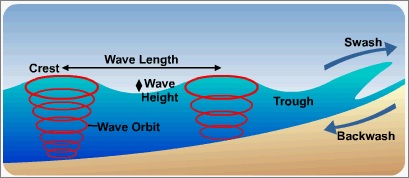
The marine agent of erosion operates as corrasion, attrition, hydraulic action & solution to transform the coastal landscape.
The waves are armed with rock debris of all sizes & shapes. They charge against the base of the cliffs and wear them back by corrasion.
The work is completed by on-coming currents & tides. They sweep the eroded material into the sea.
The constantly moving waves carry beach materials such as boulders, pebbles, shingles & fine sand with themselves. They hurl these materials against each other until they are broken down into very small pieces.
The grinding & polishing of such fragmented materials against the cliff faces & against each other is largely responsible for the fine sand which forms the beaches.
The waves that splash against the coast, enter the joints & crevices in the rocks. The air inside those cracks gets imprisoned and compressed.
When the waves retreat, the compressed air expands with explosive violence. This action repeats, again and again, it enlarges the cracks which result in rock fragments prised apart.
On limestone coasts, the solvent action of the seawater on calcium carbonate sets up chemical changes in the rocks & disintegration takes place.
1 Capes & Bays
On the coasts that are exposed to the continual action of waves, the rocks of varying resistance cause the coastline to be eroded irregularly. It happens in areas where hard rocks occur in an alternate band with softer rocks.
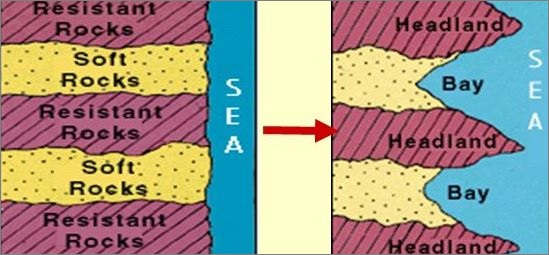
2 Cliffs & Wave cut platforms
Any steep rock platform adjoining the coast forms a cliff and its rate of recession depends on its geological structure which is the stratification & jointing of the rocks & their resistance to wave attack.
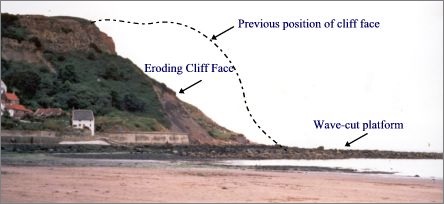
If the bed dips seaward, large blocks of rock will be dislodged & fall into the sea. The cliff will rise in a series of steps whereas if the beds dip landward, the cliff will be more resistant to wave erosion.
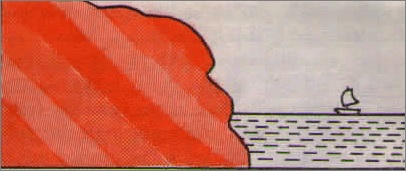
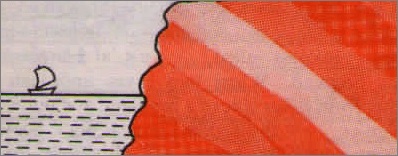
At the base of the cliff, the sea cuts a notch undermining the cliff so that its collapses. As the cliff recedes landwards under the pounding of waves, an eroded base is left behind called a wave-cut platform.
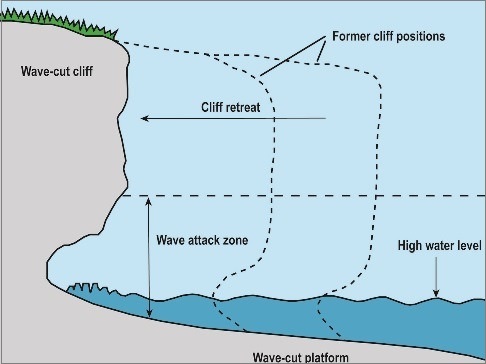
3 Cave, Arch, Stack & Stump
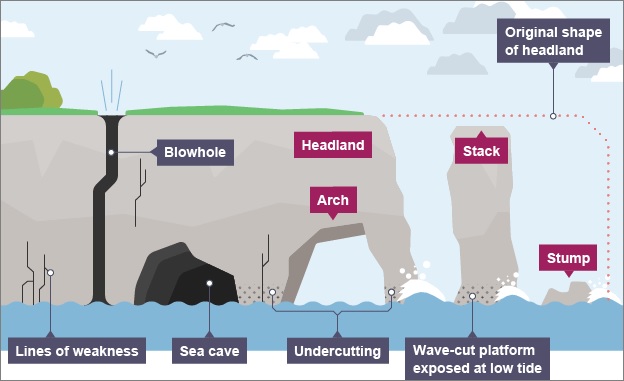
4 Geos & Gloups (blow-holes)
The occasional splashing of waves against the roof of the cave enlarges the joints inside them. The air gets compressed & released repeatedly inside them.
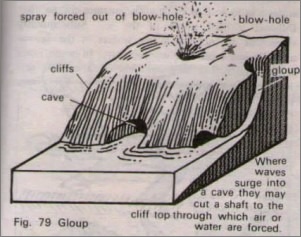
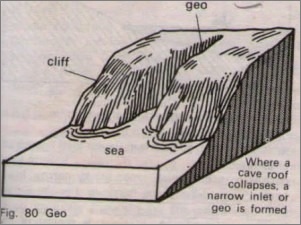
1 Beaches
Waves deposit the sand & gravel loosened from the land along the shore as beaches. There are distinct ways in which the eroded material is transported along the shore.
The coarser materials are dropped by the waves at the top of the beaches while the finer materials are carried down the beach by the backwash and dropped closer to the sea.
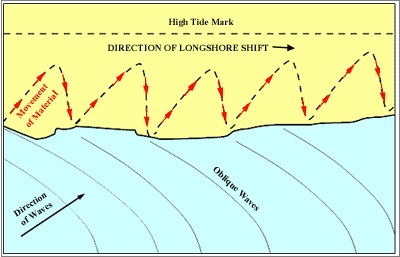
2 Spits & Bars
The debris eroded by waves is continually moved by longshore drift & where there is an indentation in the coast, such as at the mouth of the river or a bay; material may continue to be deposited across the inlet. As more materials are added, they will pile up into a ridge or embankment of shingle forming a spit.
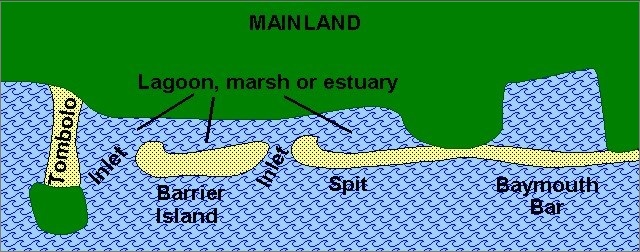
3 Marine Dunes & Dune Belts
A large amount of coastal sand is driven landwards forming extensive marine dunes that stretch into dune belts with the force of on-shore winds.

Share:







Comments
Waiting for your comments